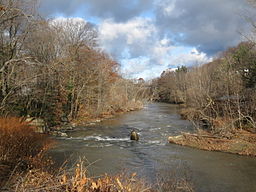Eighteen Mile Creek (Erie County)
| Eighteen Mile Creek | |
|
Eighteen Mile Creek in Hamburg, New York.
|
|
| Country | United States |
|---|---|
| State | New York |
| Region | Western New York |
| County | Erie County |
| Tributaries | |
| - right | South Branch Eighteen Mile Cr. |
| Primary source | |
| - location | Town of Concord |
| - coordinates | 42°33′23″N 78°41′28″W / 42.55639°N 78.69111°W |
| Secondary source | South Branch Eighteen Mile Cr. |
| - location | Town of North Collins |
| - coordinates | 42°32′17″N 78°45′51″W / 42.53806°N 78.76417°W |
| Source confluence | |
| - location | Town of Hamburg |
| - coordinates | 42°41′58″N 78°54′12″W / 42.69944°N 78.90333°W |
| Mouth | Lake Erie |
| - location | Highland-on-the-Lake, Town of Evans |
| - coordinates | 42°43′05″N 78°58′09″W / 42.71806°N 78.96917°WCoordinates: 42°43′05″N 78°58′09″W / 42.71806°N 78.96917°W |
| Basin | 310 km2 (120 sq mi) |
Eighteen Mile Creek (also known as Eighteenmile Creek) is a tributary of Lake Erie located in southern Erie County, New York, United States. The creek is the second largest tributary of Lake Erie in New York State.
The name is derived from the creek's distance south of the Niagara River in Buffalo. The creek was named Koughquaugu Creek by the Seneca Nation.
From its source in the Town of Concord, Eighteen Mile Creek flows north and then west before entering Lake Erie at the community of Highland-on-the-Lake in the Town of Evans. It has one major tributary, the South Branch Eighteen Mile Creek, which joins the main branch within Eighteen Mile Creek Park in the Town of Hamburg. The creek drains an approximately 120-square-mile (310 km2) watershed.
The lower section of Eighteen Mile Creek has been known for its abundance of fossils since the 19th century. The faces of the creek's gorges expose bands of shale overlain by limestone which yield numerous fossils dating from the middle to late Devonian Period. These include corals such as Heliophyllum and Favosites in addition to various species of crinoids, brachiopods, bryozoans, bivalves, and trilobites.
Portions of the creek and surrounding area in the Town of Hamburg have been designated as a "Critical Environmental Area" due to its abundance of fossils.
...
Wikipedia


